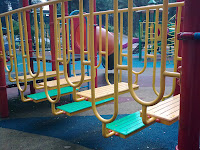
 I reluctantly decided to go out cos we finally had a cooler morning today. So off we went to Desa Park City again, this time to check out the playground there.
I reluctantly decided to go out cos we finally had a cooler morning today. So off we went to Desa Park City again, this time to check out the playground there. 
... in helping my son to be all that he can be. This blog was set up to document his progress and share activity ideas with other caregivers.

 I reluctantly decided to go out cos we finally had a cooler morning today. So off we went to Desa Park City again, this time to check out the playground there.
I reluctantly decided to go out cos we finally had a cooler morning today. So off we went to Desa Park City again, this time to check out the playground there. 


 I loved the vibrant colours of the birds - macaws, toucans, lories & those in the oriental birds aviary. Stunning! There was a section of the aviary (World of Parrots) which allowed visitors to feed special liquid bird food to the lories, parakeets etc. See photo above.
I loved the vibrant colours of the birds - macaws, toucans, lories & those in the oriental birds aviary. Stunning! There was a section of the aviary (World of Parrots) which allowed visitors to feed special liquid bird food to the lories, parakeets etc. See photo above. 
 We did spot the emus & ostriches as we rested at a hut overlooking the Flightless Birds section. Unfortunately a gust of wind blew the wrong direction, from their enclosures to where we were & the smell of their droppings made my son vomit.
We did spot the emus & ostriches as we rested at a hut overlooking the Flightless Birds section. Unfortunately a gust of wind blew the wrong direction, from their enclosures to where we were & the smell of their droppings made my son vomit.For more details about the Bird Park, head over their website: http://www.klbirdpark.com/index.htm
Note that there's a special rate if you bring along your MyKad & Jusco card/MJ card. If your child has the Orang Kurang Upaya (OKU) card, bring it along too cos they'll waive his entrance fee. I also noted that it's rather wheelchair friendly.


 The set on the left is on objects that fly. The set on the right is on ocean animals.
The set on the left is on objects that fly. The set on the right is on ocean animals.
 The set on the left is on pets. The set on the right is on farm animals.
The set on the left is on pets. The set on the right is on farm animals.


There are other activities & crafts from Playhouse Disney - just get to their main website, then click on the "celebration centre" icon and choose the festival you want e.g. christmas, hari raya.
This game helps in:
- fine motor (picking up one card at a time from a pile of cards; putting it on the central pile)To strengthen his auditory skills, the article advised to encourage them to listen to music & accompany verbal directions with visual cues. When I teach him how to cross the road safely, I point left when asking him to look left, then point right when asking him to look right etc.
I like the fact that the article included this paragraph: "In the end, what mattres most is that you nuture and support your child's learning, no matter what his style. Follow his lead & focus not on how great he's becoming at certain subjects but how great he is in general. Good parenting counts most as it's essential for learning and discovery."
For the article on visual learning, which also has links to other learning styles:
http://www.babycenter.com/0_the-visual-learner_1381276.bc

Look at his writing of number 2, bottom left of photo
I was really surprised with his writing of number 2. Of course, it's not perfect. I dont expect it to be given his disability. I'm just very glad that he's progressed, without me forcing him to do pages of writing.
He wrote it using the chunky Tesco marker pens. The sheet was laid on a hard surface, over a small plastic container about 20cm in height. He was seated on the floor.
This worksheet is available for free from www.learningpages.com. The sheets are graded by skills & are grouped by themes. The sheet in the photo has the aim of teaching to count & to write numbers 1 & 2. I like his letter "S" on the right The photo above is of his writing on a big whiteboard, which was placed on the floor, leaning against a wall. He used whiteboard marker.
I like his letter "S" on the right The photo above is of his writing on a big whiteboard, which was placed on the floor, leaning against a wall. He used whiteboard marker.
Depiction of a face
His drawing seems to have evolved. The eyes are now circles instead of dots. The nose is a "V" instead of a dot. I think the ">" on the left of the face is either an arm/hands or an ear. He drew this today while I was out. I just noticed it & he's asleep now so I didnt have the chance to ask him what the ">" symbolised.

 He probably needed a change of scenery. Or it could have been too hot & sunny for him as the children's playground at Titiwangsa Park is not shaded. The Neurosuit tends to be hot as it adds another layer in our already hot & humid weather. The smaller children's playground at Lake Gardens is partially shaded.
He probably needed a change of scenery. Or it could have been too hot & sunny for him as the children's playground at Titiwangsa Park is not shaded. The Neurosuit tends to be hot as it adds another layer in our already hot & humid weather. The smaller children's playground at Lake Gardens is partially shaded. He was happy to be back in Lake Gardens. We used to often bring him there before we discovered Titiwangsa. This bridge is still one of his favourite pieces of equipment (see photo above).
He was happy to be back in Lake Gardens. We used to often bring him there before we discovered Titiwangsa. This bridge is still one of his favourite pieces of equipment (see photo above).


I also noted that he sat more often in a cross legged manner rather than his usual 'W' sitting over this past weekend - it's an improvement.
She said that although the stability of his hips have improved (compared to a year ago) it still needs to be more stable in order for his jaw to correspondingly be more stable, to see further improvements in his speech.
2. Reading
He surprised me by being able to 'read' these words that I showed him in a book of his: bed, hat, can. He didnt need me to say out the phonic sounds of each letter. He too didnt need to say out the phonic sound of each letter. He merely said the name of the letters, then said out the word.
He continues to speak in short phrases, occasionally a long phrase/sentence comes out. He still babbles which I imagine it to be him practising his speech muscles. I'm trying to remember to model sentences for him to repeat. I do it as and when the situation arises (as opposed to creating new activities for him) so, I do tend to forget sometimes.
He's had a few meltdowns with me because I absolutely could not figure out what he was saying. Not many, just perhaps one a day, for 3 days in the last week or so. Happens when he's hungry & tired. I imagine it'll be difficult when he goes to kindergarten where teachers & friends minght not understand most of his speech. Perhaps having me as his shadow aide is therefore required due to his speech impairment & not just motor impairment.
I've been "singing" the short vowel sounds partly for him to be familiar with them & for me to learn how to say them accurately. His speech therapist says that short vowel / long vowel sounds are difficult for us Malaysians cos we speak English differently from the Westerners. So I've to learn it before I can teach him properly. After 2 days of making it into a catchy jingle, he can say the short vowel 'a' sound more accurately (but not perfectly). Previously he says the sound of 'a' with Malay pronounciation (e.g. 'a' as in the word 'baca').

Reason: he either skips a syllable or says some syllable very softly compared to the other syllables in the same word or phrase.